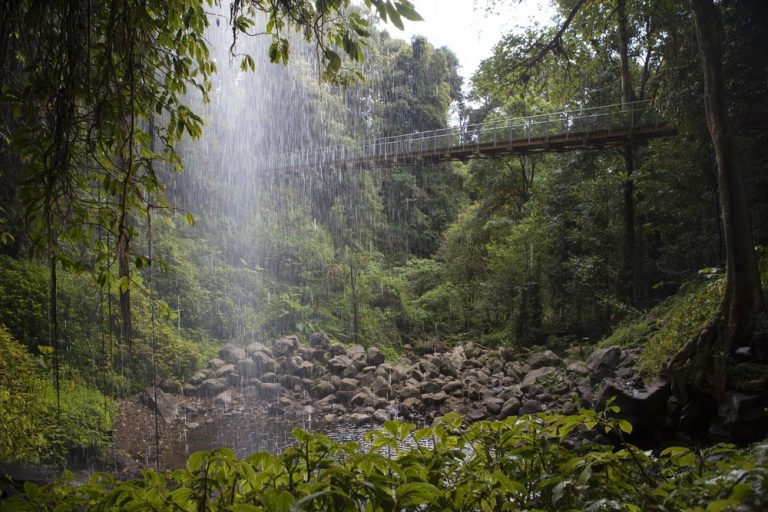By Lyndal Phillips
From timber logging up and down the precarious Dorrigo Mountain to whales…
The Coffs Coast is a pocket of paradise located between Sydney and Brisbane on the mid-north coast of NSW, Australia. Because of its varied geology, this is a region astoundingly rich in environmental diversity.
From ancient mountain escarpments to World Heritage-listed rainforests, across golden beaches to the magical sea life of the Solitary Islands Marine Park, the Coffs Coast is a land of wonder. Such wonder and natural beauty begs to be explored.
Traditional owners
The Gumbaynggirr represent one of the largest coastal Aboriginal nations in New South Wales, and are the traditional owners of the Coffs Coast. Theirs was a land of fertile soil, temperate climate, pristine rivers and abundant marine life.
Because these were a people rich in resources, and willing to share with other Aboriginal nations, the Gumbaynggirr became known as the ‘sharing people’. If you’d like to learn more about the history of the ‘sharing people’, visit the Arrawarra Sharing Culture Project.
European settlement
Europeans settled around the Coffs Coast from 1848. Local legend has it that a gang of convicts, on the run and seeking refuge, were among the first of these Europeans to settle in the area, hiding out on Muttonbird Island.
Coffs Harbour owes its name to shipbuilder, Captain John Korff. He named the area Korff’s Harbour after taking shelter there from a storm during 1847. But the Captain’s namesake was short lived as the name was accidentally changed to Coffs Harbour by a surveyor during 1861.
Ship building
The reefs and islands of the harbour were treacherous and difficult to navigate. Hence, ship building was an important local industry until the wreck of the Carywell in 1865. As a consequence, many shipping companies boycotted the area until the construction of the first lighthouse in 1878.
Yet, the busy port was visited by up to 450 ships visited each year. Of these, many ships arrived to collect valuable cargo from the timber-getters of the Dorrigo plateau.
Timber getting
Timber getters were among the first Europeans to occupy the Coffs Coast. These early settlers came seeking the “red gold” of the cedar tree. Favoured for its rich mahogany tones, this timber was highly sought after by the furniture makers of the colony.
Cedar trees grew with abundance in the sub-tropical rainforests high on the Dorrigo plateau. Logging was a dangerous but highly lucrative business. Many fortunes were made with an axe, a bullock team, a dash of daring and a whole lot of muscle.
The workers hauled the timber out of remote gullies. Tied together as rafts, the logs were floated to the coastal ports downriver. Each year, hundreds of ships collected the timber for transportation to Sydney.
Cedar cutters moved up and down what was then a very remote Coffs Coast. Because of its remoteness and a steep and narrow mountain pass, it was a tough way to earn a living. Regardless, the industry flourished into the early 1900s.
Banana growing
The local banana growing industry was established in the early 1900s. The crops fared well and by the 1920s, banana plantations were among the most highly profitable businesses on the Coffs Coast. In acknowledgement of this celebrated agricultural asset, The Big Banana is one of the most famous tourist attractions on the Coffs Coast.
Today, the region produces approximately 15 per cent of Australia’s bananas. Tourists still flock to be photographed beside ‘the biggest banana in the world’, which has recently celebrated its 50th birthday!
North coast railway line
The first north coast railway line was built between 1905 and 1932. The construction of the line was a great feat due to the many bridges required for numerous river crossings.
With the expansion of the railway came an influx of visitors to the Coffs Coast. Since the opening of the Coffs Harbour train station in 1915, tourism has grown to become the biggest industry of the region.
Visitors today still enjoy visiting the historic bridges and picturesque rail stations of the north coast rail line.
If you enjoy reading about railway history, and viewing historical photographs, further information can be found on the NSWRail website.
Whale-watching
Whale-watching has always been a popular tourist attraction of the region. Marine scientists estimate that up to 20,000 whales are on the move along the Coffs Coast. The whales migrate to the north from April to August and return to the south from September to November.
There are numerous headlands and lookouts across more than 90kms of beaches, all just perfect for sighting these magnificent creatures. Visitors seeking an up close and personal whale-watching experience can venture out on one of the many whale-watching boat tours running in the area.
Wonder and beauty
The Coffs Coast is the only region of NSW where the Great Dividing Range meets the ocean. There are few places in the world where sub-alpine, sub-tropical and sub-marine environments all co-exist with such beauty, in the one area.
Further information regarding the history of the Coffs Coast can be obtained through the Coffs Harbour Regional Museum.
Main image: shutterstock.com





